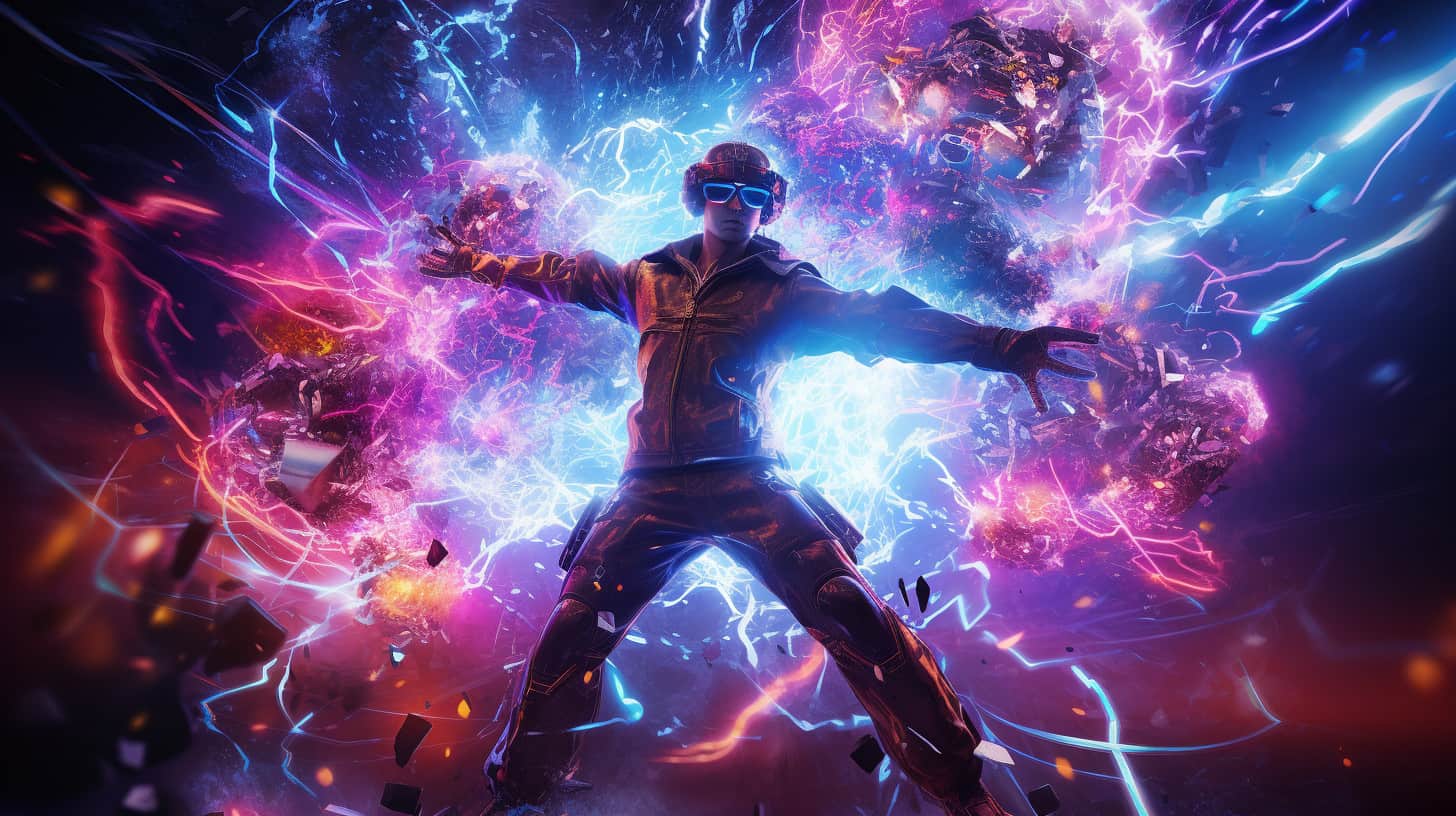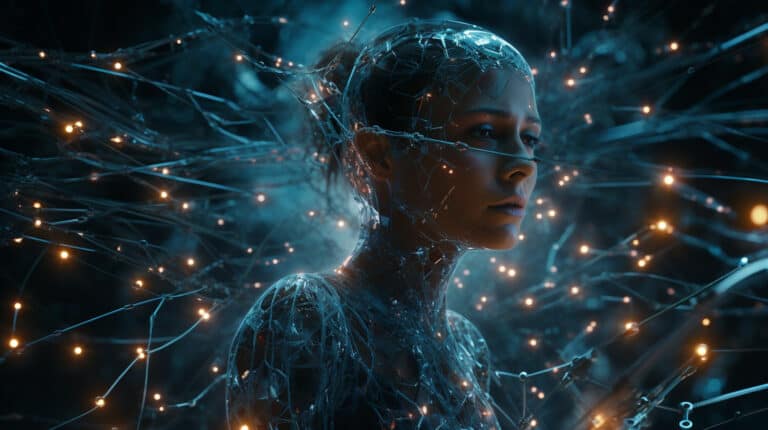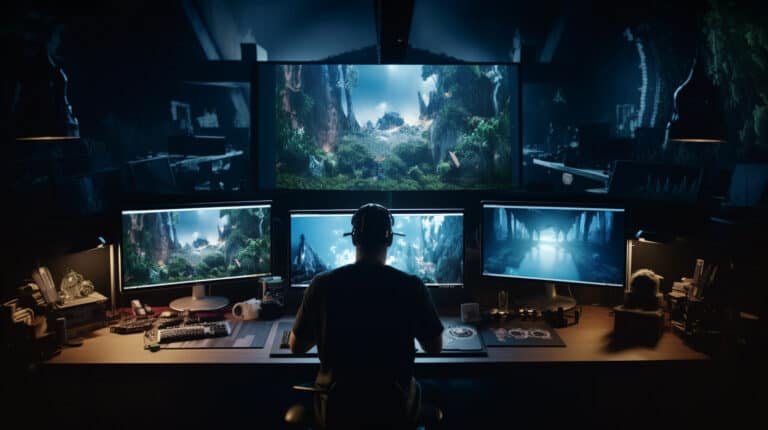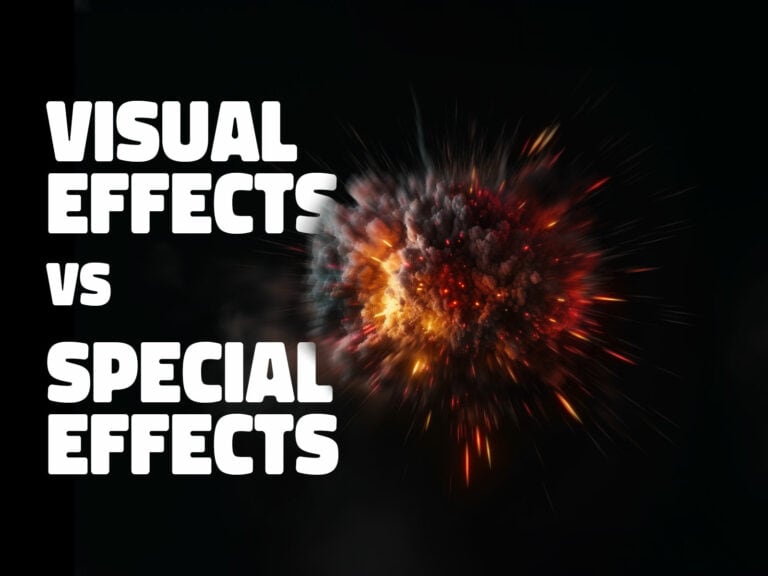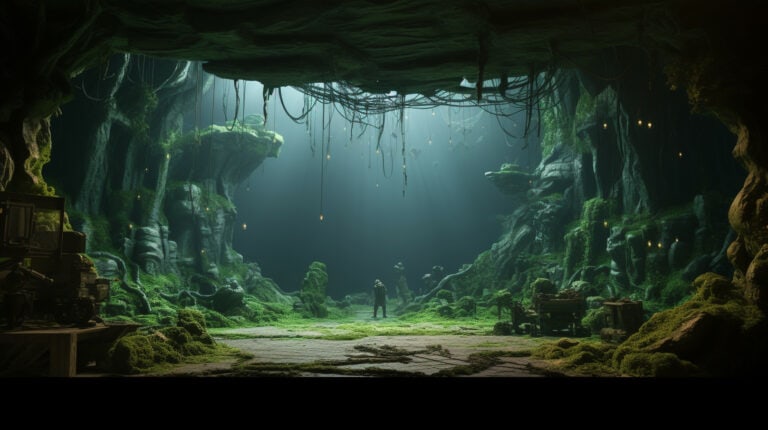Visual Effects in Games
Are you ready to be immersed in a world where reality meets imagination?
In this article, we will explore the fascinating realm of visual effects in games. From explosive battles to stunning landscapes, visual effects bring your gaming experience to life.
Discover the history, types, and technical aspects of these eye-catching features.
Join us as we uncover the role of visual effects in game design and their impact on the ever-evolving game industry.
Get ready to level up your gaming experience!
Key Points:
- Visual effects in games enhance the overall gaming experience by manipulating and enhancing the appearance of in-game objects, characters, and environments.
- They contribute to the realism and believability of the gaming world and serve gameplay purposes, such as indicating damage or highlighting important objects.
- Visual effects bring games to life by creating stunning and realistic environments, evoke emotions, and enhance storytelling.
- They provide crucial feedback during gameplay, indicating the success or failure of actions and communicating important information.
Introduction
Get ready to explore the exciting world of visual effects in games.
Visual effects play a crucial role in enhancing your gameplay experience by creating stunning and immersive environments.
From realistic explosions to mesmerizing particle effects, these visual elements bring games to life and make your gaming adventures even more thrilling.
Definition of visual effects in games
Visual effects in games are commonly used to enhance the overall gaming experience, providing players with an immersive and visually captivating environment. These effects bring virtual worlds to life, creating stunning visuals that transport players into a different reality. But what exactly are visual effects in games? They encompass a wide range of techniques and technologies that manipulate and enhance the appearance of in-game objects, characters, and environments. From realistic lighting and shadows to explosive particle effects and dynamic weather systems, visual effects contribute to the realism and believability of the gaming world. They can also serve gameplay purposes, such as indicating damage or highlighting important objects. The following table provides a glimpse into the diverse range of visual effects commonly used in games:
| Visual Effect | Description |
|---|---|
| Motion Blur | Blurring of fast-moving objects to simulate the perception of motion. |
| Depth of Field | Adjusting the focus to create a sense of depth and emphasize certain objects. |
| Ambient Occlusion | Simulating the softening of shadows in areas where objects come into contact. |
| Bloom | Creating a glow effect around bright objects to simulate high-intensity light. |
These are just a few examples of the myriad visual effects that game developers utilize to enhance the gaming experience. By employing these techniques, games can create stunning visuals that captivate players and transport them into fantastical worlds.
Importance of visual effects in enhancing the gameplay experience
Enhance your gameplay experience with the importance of visual effects in games. Visual effects play a crucial role in immersing you in the virtual world and elevating your gaming experience. Here are three reasons why visual effects are vital:
1. Realism: Visual effects bring games to life by creating stunning and realistic environments. From lifelike landscapes to detailed character models, these effects make you feel like you’re part of the game.
2. Emotional Impact: Visual effects can evoke emotions and enhance storytelling. Dynamic lighting, particle effects, and cinematic sequences can intensify suspense, excitement, and awe, making the gameplay more engaging and memorable.
3. Gameplay Feedback: Visual effects provide crucial feedback during gameplay. They can indicate the success or failure of actions, highlight important objects or enemies, and communicate important information, such as health and energy levels.
By understanding the importance of visual effects, you can fully appreciate the immersive and captivating experiences that games offer.
Now, let’s delve into the history of visual effects in games.
History of Visual Effects in Games
Get ready to take a trip down memory lane as we explore the history of visual effects in games.
From the early days of pixelated graphics to the cutting-edge technology of today, the evolution of visual effects in video games has been nothing short of remarkable.
We’ll also be highlighting some key milestones in the development of visual effects technology that have paved the way for the stunning visuals we see in modern games.
Evolution of visual effects in early video games
As you explore the history of visual effects in early video games, you’ll discover the remarkable evolution that occurred within the gaming industry. The early days of gaming may seem primitive compared to the graphics we see today, but they laid the foundation for what was to come.
Here are three key points that highlight the evolution of visual effects in early video games:
1. Limited graphics: In the early days, games were limited by the technology available, resulting in simple and pixelated graphics. Despite these limitations, game developers pushed the boundaries to create immersive experiences.
2. Advancements in hardware: As technology progressed, so did the capabilities of gaming hardware. From improved processors to better graphics cards, these advancements allowed for more detailed and realistic visual effects.
3. Artistic innovation: Game developers began to experiment with new techniques and artistic styles to enhance visuals. From vibrant color palettes to clever use of sprites, these innovations helped create visually stunning games.
With these advancements in mind, let’s now delve into the milestones in the development of visual effects technology.
Milestones in the development of visual effects technology
One significant milestone in the development of visual effects technology in games is the introduction of real-time 3D graphics. This breakthrough allowed game developers to create immersive and visually stunning worlds that players could explore in real-time.
Gone were the days of flat, 2D graphics; now, games could offer depth, perspective, and a sense of realism like never before. With the ability to render complex models and environments in real-time, games became more visually appealing and engaging.
This milestone not only revolutionized the gaming industry but also paved the way for future advancements in visual effects technology. Today, we take for granted the incredible graphics and lifelike animations in modern games, but it all started with the introduction of real-time 3D graphics.
Types of Visual Effects in Games
Get ready to explore the mesmerizing world of visual effects in games. From dazzling particle effects that bring explosions to life, to realistic lighting effects that create immersive environments, the types of visual effects in games are truly awe-inspiring.
Brace yourself for the storm as weather effects add an extra layer of realism, while physics-based effects make the game world feel dynamic and interactive. And let’s not forget the intricate character animations that breathe life into the virtual avatars.
Get ready to dive into a world where visuals come alive and immerse you in the gaming experience.
Particle effects
To enhance the immersive experience, games utilize a wide range of particle effects that add depth and realism to the visuals. These effects are created by simulating the behavior of particles such as fire, smoke, water, and explosions.
Here are three types of particle effects commonly used in games:
1. Fire: Flames that flicker and dance, casting dynamic shadows and emitting heat.
2. Smoke: Billowing clouds that create an eerie atmosphere and obscure visibility.
3. Explosions: Powerful bursts of energy that send debris flying and leave a trail of destruction.
These particle effects not only make games visually stunning but also contribute to the overall gameplay experience. They create a sense of immersion, making you feel like you’re truly part of the virtual world.
Lighting effects
Experience the immersive power of lighting effects in games as they bring depth, atmosphere, and realism to virtual worlds. From the flickering glow of a candle to the harsh glare of a neon sign, lighting effects play a crucial role in creating the visual ambiance of a game. They can enhance the mood and tone of a scene, guide the player’s attention, and even provide gameplay cues.
Realistic shadows, dynamic lighting, and global illumination techniques all contribute to creating a believable and captivating virtual environment. Whether it’s the warm glow of a sunset or the eerie illumination of a dark alley, lighting effects add an extra layer of immersion to gaming experiences.
As we explore the impact of lighting effects, we’ll also delve into the next subtopic – weather effects – to further enhance the realism in games.
Weather effects
Immerse yourself in the immersive power of weather effects in games, as they add an extra layer of realism and atmosphere to virtual worlds. Weather effects can greatly enhance the player’s experience, making them feel like they’re truly part of the game world.
Here are three types of weather effects commonly found in games:
1. Rain: The sound of raindrops hitting surfaces and the sight of wet streets and buildings can create a sense of melancholy or mystery, depending on the game’s tone.
2. Snow: Snow-covered landscapes and falling snowflakes can evoke a feeling of tranquility and wonder, especially in open-world games.
3. Thunderstorms: The rumbling thunder, flashes of lightning, and darkened skies during a thunderstorm can add tension and excitement to gameplay.
As you step into the world of weather effects, get ready to discover how physics-based effects can further enhance your gaming experience.
Physics-based effects
As you delve deeper into the world of visual effects in games, you’ll discover the captivating impact of physics-based effects on your gameplay. These effects simulate real-world physics, adding a level of realism and immersion to the virtual environment.
From realistic object interactions to accurate simulations of gravity, physics-based effects enhance the overall gaming experience. Imagine the thrill of watching objects realistically collide and break, or the satisfaction of seeing water react realistically to your character’s movements. These effects not only make the game more visually appealing but also affect gameplay mechanics.
Realistic physics can determine the trajectory of projectiles, the behavior of vehicles, and even the way characters move and respond to their environment. With physics-based effects, games become more dynamic, challenging, and lifelike, bringing you closer to the virtual world like never before.
Character animations
Continue to explore the world of visual effects in games by delving into the captivating realm of character animations. Character animations play a crucial role in bringing virtual worlds to life, immersing players in the game and enhancing their overall experience.
Here are three fascinating aspects of character animations that will surely pique your interest:
1. Fluid movements: From running and jumping to combat sequences, character animations add a sense of realism and smoothness to the actions of in-game characters. The fluidity of these movements can greatly impact the player’s engagement and enjoyment.
2. Expressive gestures: Through facial expressions, body language, and gestures, character animations convey emotions, personality traits, and intentions. These subtle details can help players form deeper connections with the characters and become more invested in the game’s narrative.
3. Dynamic interactions: Character animations enable interactions between in-game characters and the environment, allowing for dynamic and immersive gameplay experiences. Whether it’s climbing obstacles, opening doors, or performing acrobatic stunts, these animations make the game world feel alive and responsive.
With character animations, game developers can create more believable and engaging virtual worlds, further enhancing the role of visual effects in game design.
Role of Visual Effects in Game Design
As a game designer, you understand the crucial role that visual effects play in creating an immersive and realistic gaming experience. These effects not only enhance the overall immersion of players in the virtual world, but they also serve as a means to communicate important gameplay information.
From highlighting interactive objects to signaling danger, visual effects play a vital role in guiding players through the game. Moreover, they have the power to create memorable moments and experiences that players will cherish long after they’ve put down the controller.
Enhancing immersion and realism
To truly immerse players in a game and create a realistic experience, visual effects play a crucial role in game design. These effects have the power to transport players into virtual worlds and make them feel like they’re part of the action.
Here are three ways in which visual effects enhance immersion and realism in games:
1. Realistic environments: Visual effects can create stunning landscapes, detailed textures, and dynamic lighting that make game worlds feel alive and believable.
2. Authentic character animations: By using motion capture technology and advanced animation techniques, visual effects can bring characters to life with realistic movements and expressions.
3. Immersive sound design: Visual effects aren’t just limited to visuals; they can also enhance immersion through realistic and immersive sound effects that create a sense of presence and depth.
With these visual effects, games can transport players to new worlds and provide experiences that feel incredibly real.
Now, let’s explore how visual effects are also instrumental in communicating gameplay information.
Communicating gameplay information
Visual effects in games play a crucial role in conveying gameplay information to you, the player. They help you understand the mechanics, objectives, and interactions within the game world. Through visual cues and feedback, these effects provide vital information that guides your decision-making and helps you navigate complex game systems.
For example, a red flash on the screen could indicate low health, prompting you to seek healing or take cover. Similarly, a glowing object might signify an important item or objective that you need to progress in the game. By effectively communicating gameplay information, visual effects enhance your understanding of the game and enable you to make informed choices.
As we explore the next section on creating memorable moments and experiences, it’s important to recognize how visual effects contribute to these immersive and engaging gameplay experiences.
Creating memorable moments and experiences
To fully immerse yourself in a game and create unforgettable experiences, visual effects play a crucial role in game design. These effects have the power to captivate players and make them feel like they’re part of another world. Here are three ways visual effects can create memorable moments and experiences in games:
1. Epic cinematic sequences: Visual effects can bring breathtaking moments to life, from explosive battles to stunning landscapes. These sequences leave a lasting impression and make players feel like they’re part of a grand adventure.
2. Emotional impact: By using visual effects to enhance storytelling, games can evoke strong emotions in players. Whether it’s a heart-wrenching cutscene or a thrilling chase, these moments stay with players long after they put down the controller.
3. Immersion and atmosphere: Visual effects can transport players to different worlds and create immersive environments. From realistic lighting and weather effects to detailed character animations, these elements make players feel like they’re truly inhabiting the game’s universe.
Technical Aspects of Visual Effects in Games
Now let’s explore the technical side of visual effects in games.
You’ll need to consider the hardware and software requirements to ensure your game can handle the demands of these effects.
Additionally, optimization techniques for real-time rendering are crucial for maintaining smooth gameplay.
Finally, integrating visual effects into game engines is key to achieving a seamless and immersive experience.
Hardware and software requirements
For optimal performance and stunning visual effects in games, you need to meet the hardware and software requirements. These requirements ensure that your gaming experience is smooth and immersive.
Here are three key factors to consider:
1. Graphics Card: A powerful graphics card is essential for rendering high-quality visuals in games. Look for cards with dedicated VRAM and support for advanced features like ray tracing.
2. Processor: A fast and efficient processor is crucial for handling complex calculations and physics simulations in real-time. Aim for a processor with multiple cores and a high clock speed.
3. RAM: Sufficient RAM is necessary for storing and accessing game data quickly. Make sure you have enough memory to handle the demands of modern games.
By meeting these hardware and software requirements, you can unleash the full potential of visual effects in games.
Now, let’s dive into the next section and explore optimization techniques for real-time rendering.
Optimization techniques for real-time rendering
Meeting the hardware and software requirements is just the beginning; now let’s delve into the optimization techniques that will enhance real-time rendering and take your visual effects in games to the next level.
By implementing these techniques, you can achieve smooth and realistic graphics while maintaining a high frame rate.
One important optimization technique is level of detail (LOD) rendering, where objects are rendered with different levels of detail depending on their distance from the camera.
Another technique is culling, which involves determining which objects aren’t visible on the screen and excluding them from rendering.
Finally, dynamic batching allows for the grouping of similar objects to be rendered together, reducing the number of draw calls and improving performance.
These optimization techniques are essential for creating visually stunning games that run smoothly on a variety of hardware configurations.
Now let’s explore the integration of visual effects into game engines, to further enhance the overall gaming experience.
Integration of visual effects into game engines
To further enhance the overall gaming experience, integrate visual effects into game engines by leveraging their technical aspects. By seamlessly integrating visual effects into game engines, developers can create immersive and realistic worlds that captivate players.
Here are three key ways in which visual effects can be integrated into game engines:
1. Shader-based effects: Utilize shader programming to create stunning visual effects such as dynamic lighting, realistic water reflections, and particle systems. These effects can greatly enhance the visual fidelity of the game.
2. Post-processing effects: Apply post-processing techniques like motion blur, depth of field, and color grading to add a cinematic touch to the visuals. These effects can make the game look more polished and visually appealing.
3. Physics-based effects: Incorporate physics simulations to create realistic interactions between objects, such as destructible environments, cloth simulation, and realistic character animations. These effects can greatly enhance the immersion and realism of the game world.
Challenges in Implementing Visual Effects in Games
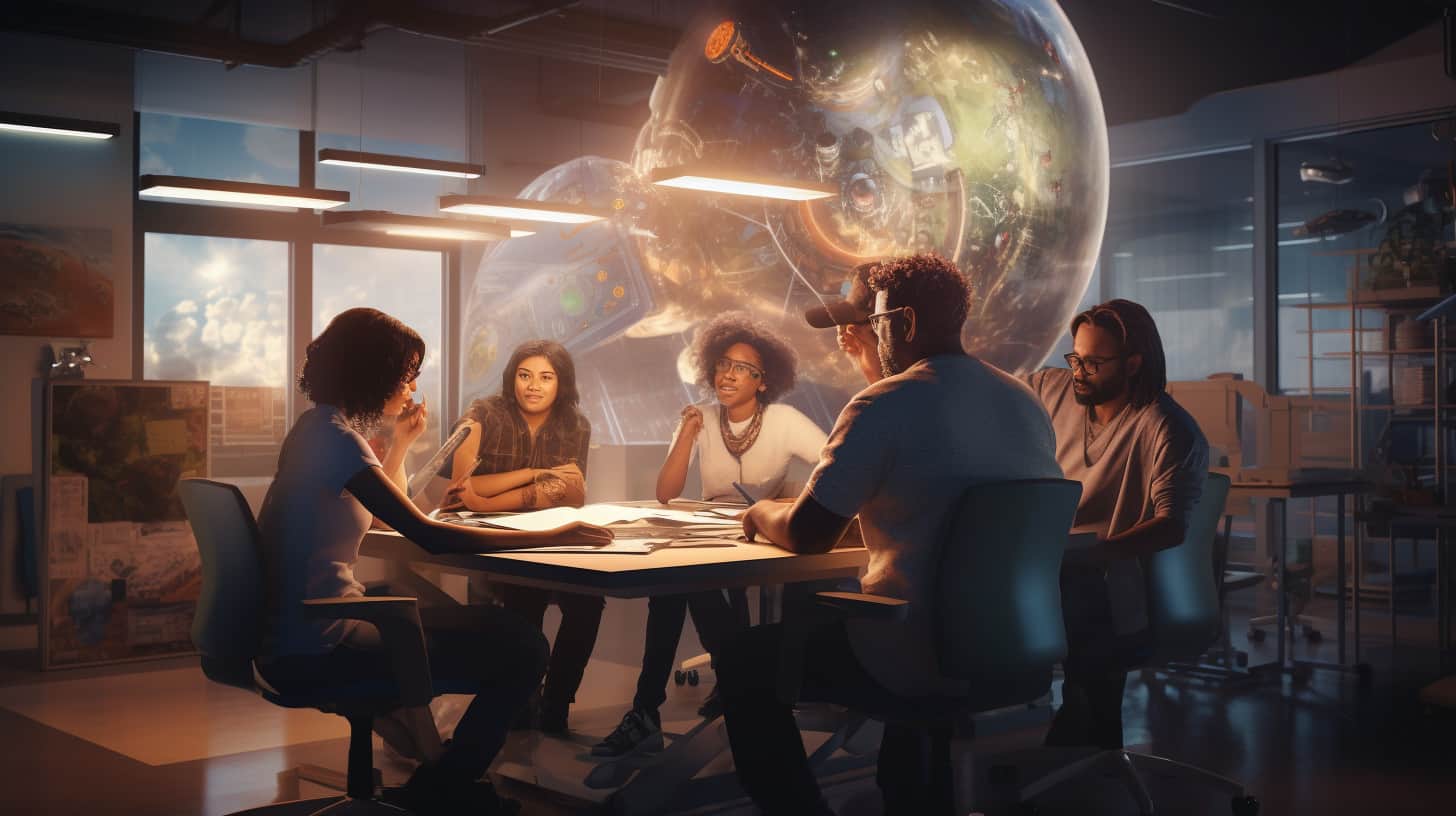
Now, let’s explore the challenges that arise when implementing visual effects in games.
One major obstacle is dealing with performance limitations and making trade-offs to ensure smooth gameplay.
Additionally, striking the right balance between visual fidelity and gameplay responsiveness can be a daunting task.
Lastly, ensuring compatibility across different platforms and devices adds another layer of complexity to the implementation process.
Let’s delve into each of these points and uncover the intricacies involved in overcoming these challenges.
Performance limitations and trade-offs
Implementing visual effects in games presents challenges due to performance limitations and trade-offs that you need to navigate. These constraints can have a significant impact on the overall gaming experience.
Here are three key aspects to consider when dealing with performance limitations and trade-offs:
1. Hardware limitations: Different gaming platforms have varying capabilities, which means that visual effects need to be optimized accordingly. Balancing the desire for stunning visuals with the constraints of the hardware can be a delicate task.
2. Processing power: Visual effects can be computationally expensive, requiring a significant amount of processing power. Finding ways to optimize and streamline these effects without sacrificing their visual impact is crucial.
3. Memory management: Visual effects often require a large amount of memory to store and render. Efficient memory management techniques, such as dynamic memory allocation and texture compression, can help maximize performance without compromising on visual quality.
Navigating these performance limitations and trade-offs is essential to ensure that games deliver an immersive and visually stunning experience while maintaining optimal performance.
Balancing visual fidelity and gameplay responsiveness
When balancing visual fidelity and gameplay responsiveness, you must carefully consider the impact of performance limitations and trade-offs on the overall gaming experience. Achieving stunning visuals is undoubtedly important, but not at the expense of smooth gameplay.
As a game developer, you strive to create a visually captivating world that immerses players in an unforgettable experience. However, you also need to ensure that the game remains responsive and playable. It’s a delicate balancing act.
Pushing the boundaries of visual effects can put a strain on hardware and lead to laggy or choppy gameplay. On the other hand, sacrificing visual fidelity for the sake of responsiveness can leave players feeling underwhelmed.
Compatibility across different platforms and devices
To ensure compatibility across different platforms and devices, game developers must prioritize optimizing visual effects. This is crucial because players expect a seamless and immersive gaming experience regardless of the device they’re using. Here are three challenges that developers face in implementing visual effects in games:
1. Performance limitations: Different platforms and devices have varying hardware capabilities, which can limit the performance of visual effects. Developers need to find the right balance between stunning visuals and smooth gameplay.
2. Screen size and resolution: Games need to adapt to different screen sizes and resolutions to provide an optimal viewing experience. Visual effects must be scalable, ensuring they look great on both small mobile screens and large desktop monitors.
3. Operating system compatibility: Games are developed for various operating systems, such as Windows, macOS, iOS, and Android. Developers must ensure that visual effects are compatible with each operating system to provide a consistent experience for players.
By addressing these challenges, game developers can create visually stunning games that run smoothly across different platforms and devices.
Now let’s explore the trends and innovations in visual effects for games.
Trends and Innovations in Visual Effects for Games
Ready to explore the cutting-edge trends and innovations in visual effects for games? Get ready to be blown away by advancements in real-time ray tracing, where lifelike reflections and lighting effects elevate the gaming experience to new heights.
And that’s not all – with the integration of machine learning, procedural effects become more dynamic and realistic, creating a truly immersive environment.
Lastly, virtual reality and augmented reality visual effects open up a whole new world of possibilities, allowing players to step into the game like never before.
Advancements in real-time ray tracing
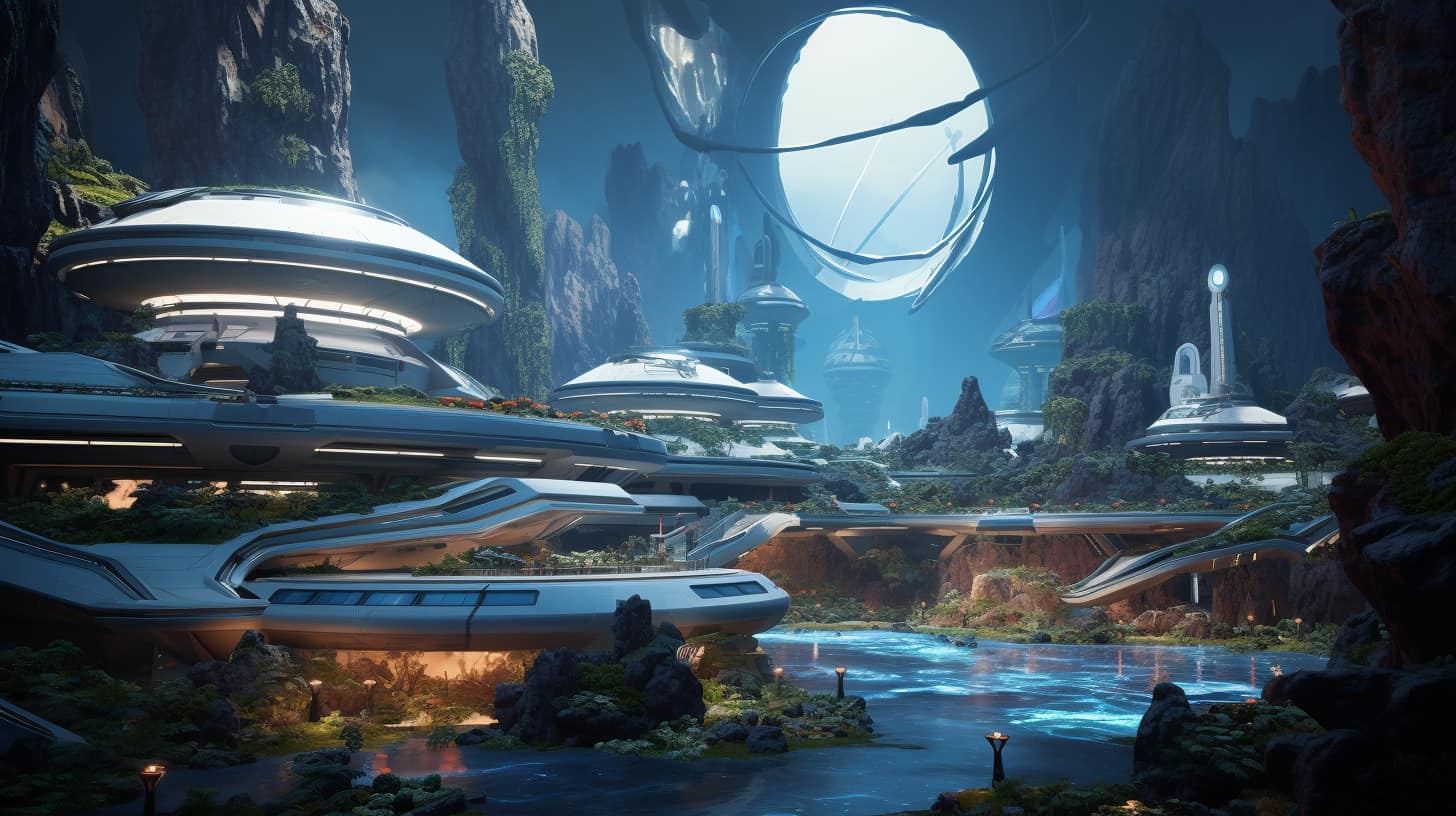
You’ll discover the cutting-edge advancements that revolutionize visual effects in games through real-time ray tracing. This technology has ushered in a new era of realism and immersion, making game worlds more lifelike than ever before.
Here are three key advancements in real-time ray tracing that are shaping the future of visual effects in games:
1) Global Illumination: Real-time ray tracing allows for accurate simulation of how light interacts with objects in a scene, resulting in realistic lighting and shadows. This creates a more immersive and dynamic gaming experience.
2) Reflections and Refractions: With real-time ray tracing, game developers can achieve stunningly realistic reflections and refractions, making surfaces and materials look more believable and natural.
3) Ambient Occlusion: Real-time ray tracing enables the accurate calculation of ambient occlusion, enhancing the depth and realism of game environments by accurately simulating how light is blocked by nearby objects.
As we delve deeper into the advancements in real-time ray tracing, it’s important to also explore the integration of machine learning for procedural effects.
Integration of machine learning for procedural effects
As you explore the advancements in real-time ray tracing, one notable trend shaping the future of visual effects in games is the integration of machine learning for procedural effects. Machine learning techniques allow game developers to create realistic and dynamic visual effects that can adapt and respond to the player’s actions in real-time. This innovative approach to procedural effects opens up a world of possibilities, from lifelike simulations of natural phenomena like water and fire, to realistic character animations and physics simulations. By training algorithms on vast amounts of data, machine learning can generate highly detailed and realistic effects that were previously time-consuming and costly to create manually. This integration of machine learning not only enhances the visual experience for players but also streamlines the development process for game developers.
| Pros | Cons |
|---|---|
| Realistic and dynamic effects | Requires large amounts of data |
| Adapts and responds in real-time | Complexity in implementing algorithms |
| Enhances visual experience | Requires computational power |
| Streamlines development process | Potential for bias in training data |
| Opens up new creative possibilities | Constant need for algorithm updates |
Virtual reality and augmented reality visual effects
How can virtual reality and augmented reality enhance visual effects in games?
Here are three ways these technologies are revolutionizing the gaming industry:
1. Immersive experiences: Virtual reality (VR) allows players to fully immerse themselves in the game world, creating a sense of presence and realism. With VR, visual effects can be enhanced to transport players to fantastical realms, bringing characters and environments to life like never before.
2. Interactive gameplay: Augmented reality (AR) overlays digital content onto the real world, blending virtual elements with the player’s environment. This opens up endless possibilities for visual effects in games, from interactive holograms to dynamic environmental changes that react to the player’s movements and actions.
3. Enhanced storytelling: VR and AR can elevate storytelling in games by providing new ways to engage players emotionally. Visual effects can be used to convey emotions, create suspenseful moments, and enhance the overall narrative experience.
With virtual reality and augmented reality, the future of visual effects in games is boundless, offering players immersive, interactive, and emotionally captivating experiences.
Impact of Visual Effects on Game Industry
Visual effects in games have a profound impact on the game industry, influencing both sales and player engagement.
The use of stunning visuals can attract players and increase their immersion in the game world, leading to higher sales and player retention.
Moreover, visual effects play a crucial role in shaping the aesthetics and genres of games, allowing developers to create unique and unforgettable gaming experiences.
Influence on game sales and player engagement
Immersiveness is significantly enhanced when visual effects are strategically integrated into games, increasing both game sales and player engagement. The impact of visual effects on the game industry can’t be overstated.
Here are three ways in which visual effects influence game sales and player engagement:
1. Captivating storytelling: Visual effects bring game narratives to life, creating a more immersive and engaging experience for players. From realistic character animations to stunning environments, visual effects help convey emotions and enhance the storytelling aspect of games.
2. Enhanced gameplay experience: Visual effects not only make games visually appealing but also improve gameplay mechanics. Whether it’s the realistic physics of objects or the dynamic lighting effects, these visual elements make the gameplay more interactive and enjoyable.
3. Marketing advantage: Eye-catching visual effects in trailers and promotional materials attract the attention of potential players. Stunning visuals create a sense of excitement and anticipation, encouraging gamers to purchase the game and engage with it.
Role of visual effects in shaping game aesthetics and genres
When it comes to shaping game aesthetics and genres, visual effects play a crucial role in creating a captivating and immersive experience for players.
Visual effects have the power to transport players to fantastical worlds, enhance storytelling, and evoke emotions. They can make the environment feel alive, whether it’s through realistic lighting, dynamic weather effects, or intricate particle systems.
Visual effects also contribute to the overall atmosphere of a game, whether it’s creating a sense of dread in a horror game or a feeling of wonder in a fantasy adventure.
Additionally, visual effects can help define the genre of a game, whether it’s the explosive action of a first-person shooter or the serene beauty of a puzzle game.
In the competitive game industry, stunning visual effects have become an essential element for attracting players and setting a game apart from the rest.
Future of Visual Effects in Games
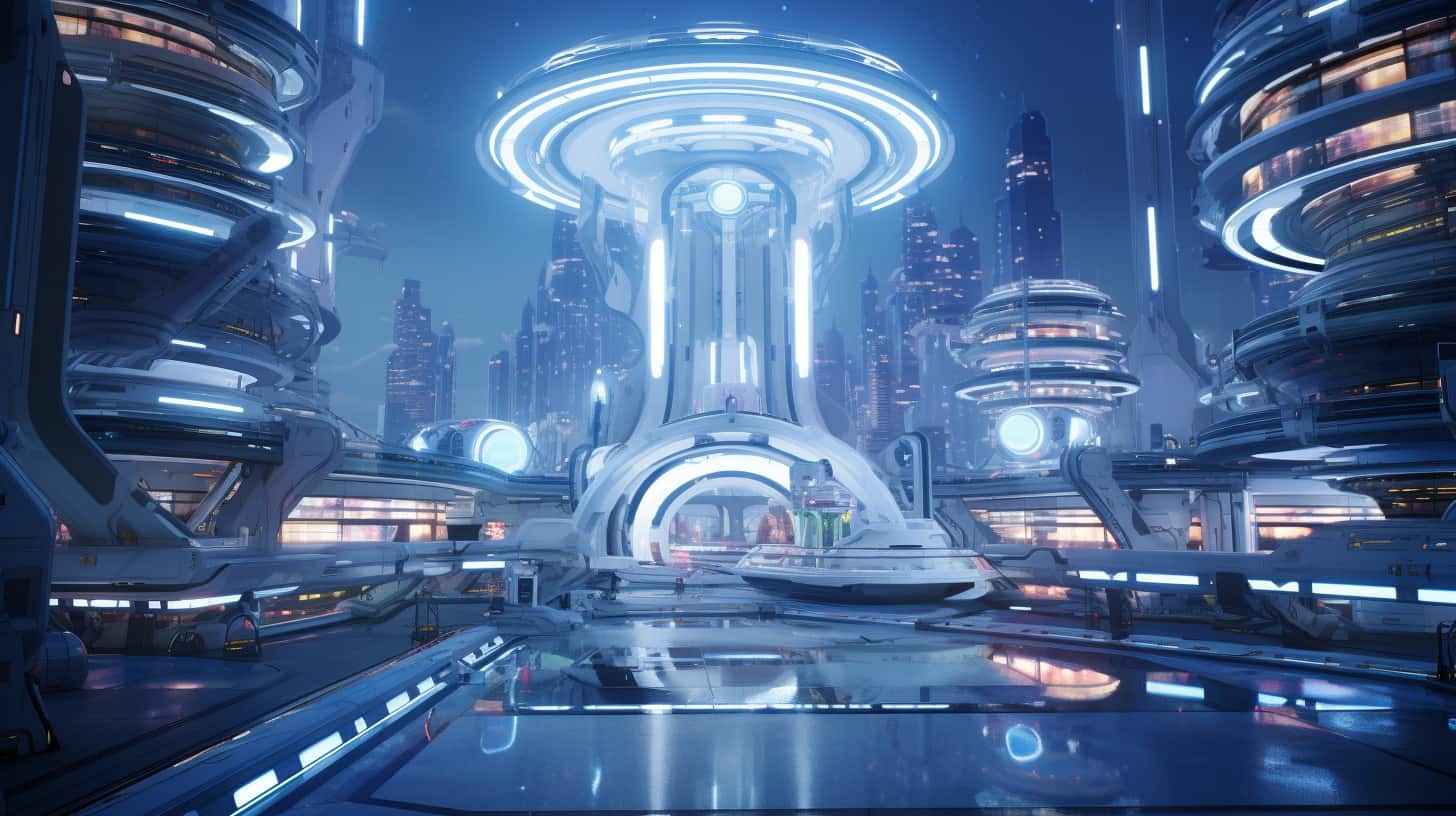
Imagine a world where games come alive with mind-blowing visuals and immersive experiences.
The future of visual effects in games holds exciting predictions for upcoming technologies and techniques that will revolutionize game development. From advanced rendering techniques to virtual reality integration, these innovations have the potential to completely transform the way games are created and played, pushing the boundaries of what’s possible in the gaming world.
Predictions for upcoming technologies and techniques
To enhance your gaming experience, upcoming technologies and techniques will bring a multitude of visually stunning and immersive effects. Get ready to be blown away by the following predictions for the future of visual effects in games:
1. Realistic lighting: With advancements in ray tracing technology, games will be able to simulate realistic lighting effects like never before. Imagine dynamic shadows, accurate reflections, and lifelike global illumination, all adding to the visual realism of your favorite games.
2. Hyper-realistic textures: Thanks to advancements in texture mapping, games will feature incredibly detailed and lifelike textures. From the roughness of a stone wall to the intricate patterns on a character’s clothing, every surface will feel tangible and realistic, pulling you deeper into the game world.
3. Interactive particle systems: Imagine games where you can interact with a world filled with dynamic and responsive particle effects. From realistic water splashes to exploding debris, these interactive particle systems will add a new level of immersion and excitement to your gaming experience.
With these upcoming technologies and techniques, the future of visual effects in games is bound to be awe-inspiring. Get ready to step into a whole new level of gaming realism!
Potential impact on game development and player experiences
With these upcoming technologies and techniques, you’ll experience a significant impact on game development and your overall player experience in terms of visual effects. As game developers continue to push the boundaries of what’s possible, the visual effects in games will become even more realistic and immersive. Imagine playing a game where the environment reacts to your every move, where the lighting and shadows are so lifelike that you feel like you’re actually there.
With advancements in real-time ray tracing and procedural generation, games will be able to deliver stunning visuals that rival those of blockbuster movies. Not only will this enhance the visual fidelity of games, but it will also allow for more dynamic and interactive gameplay experiences.
The future of visual effects in games is a bright one, promising to transport players into truly awe-inspiring virtual worlds.
Conclusion
As we wrap up this discussion on visual effects in games, it’s important to recap the significance and influence they’ve on the gaming experience.
Visual effects not only enhance immersion and realism but also play a crucial role in storytelling and gameplay mechanics.
With this in mind, it’s imperative for game developers to keep pushing the boundaries of visual effects technology to create even more captivating and unforgettable gaming experiences for players.
Recap of the importance and impact of visual effects in games
You can clearly see the significant impact and importance of visual effects in games. They’ve revolutionized the gaming industry, elevating the overall gaming experience to new heights.
Here are three reasons why visual effects are crucial in games:
1. Immersion: Visual effects transport players into captivating virtual worlds, making them feel like they’re part of the game’s universe.
2. Emotional connection: Stunning visual effects elicit strong emotional responses from players, enhancing the storytelling and creating memorable gaming moments.
3. Competitiveness: Cutting-edge visual effects attract players and give game developers a competitive edge, driving sales and success in a crowded market.
As technology continues to advance, the potential for visual effects in games is limitless. Game developers have a responsibility to push the boundaries of visual effects technology, creating even more immersive and visually stunning experiences for players.
Call to action for game developers to continue pushing the boundaries of visual effects technology
To truly stay ahead in the ever-evolving gaming industry, game developers must consistently push the boundaries of visual effects technology, ensuring that players are consistently immersed in visually stunning and captivating gaming experiences. As technology advances and players’ expectations increase, it becomes crucial for game developers to embrace innovation and continue to push the limits of what is possible in terms of visual effects. By doing so, they can create games that not only provide a visually impressive experience but also engage players on a deeper level. The table below highlights some of the key reasons why game developers should prioritize pushing the boundaries of visual effects technology:
| Reasons to push the boundaries of visual effects technology | ||
|---|---|---|
| Enhances Immersion | Boosts Player Engagement | Creates Memorable Experiences |
Frequently Asked Questions
How Do Visual Effects in Games Contribute to the Overall Immersive Experience for Players?
Visual effects in games bring the virtual world to life, captivating players with their realistic and stunning visuals. By immersing you in awe-inspiring environments and thrilling action, these effects enhance the overall gaming experience, making it more engaging and immersive.
What Are Some Common Misconceptions About the Role of Visual Effects in Game Design?
Some common misconceptions about the role of visual effects in game design include thinking they are just for show or that they don’t impact gameplay. However, these effects play a crucial role in creating immersion and enhancing the overall gaming experience.
Are There Any Specific Tools or Software That Are Commonly Used in Creating Visual Effects for Games?
There are various tools and software you can use to create visual effects for games. These tools help you bring your imagination to life and enhance the overall gaming experience for players.
What Are Some of the Ethical Considerations When Implementing Visual Effects in Games?
When implementing visual effects in games, it’s important to consider the ethical implications. Think about how the effects impact gameplay, player experience, and potential psychological effects. Balance creativity with responsibility.
How Do Visual Effects in Games Impact the Performance and Optimization of the Game?
Visual effects in games impact game performance and optimization by adding complexity and demands on hardware. They can enhance immersion, but developers must strike a balance between visual fidelity and smooth gameplay.

